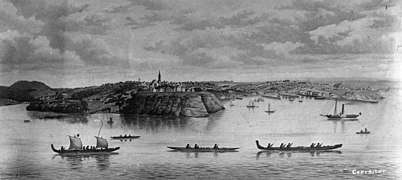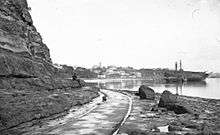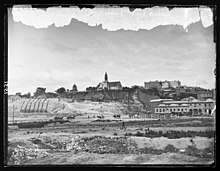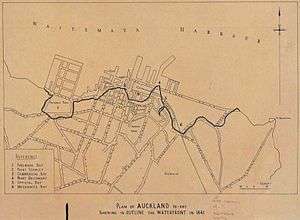Point Britomart
Point Britomart, named Te Rerenga Ora Iti by Māori, was a headland in the Waitematā Harbour, in Auckland (Tāmaki Makaurau), New Zealand. Located between Commercial Bay and Official Bay,[2] the point was later quarried away to produce fill for land reclamation in Mechanics Bay, and almost no physical trace remains at street level in what is today an area of the Auckland CBD and the Auckland waterfront.




History
Te Rerenga Ora Iti (‘the leap of the few survivors’) was the site of at least one Māori pā, and was considered an important site in Tāmaki Makaurau (Auckland isthmus), with several known battles fought over it, such as by the Ngāti Whātua iwi in the 17th and 18th centuries. The name commemorates an incident around 1680 when Ngāti Whātua drove Ngāti Huarere over the cliff to either their freedom or deaths.[3][4]
After signing the Treaty of Waitangi, Ngāti Whātua paramount chief Āpihai Te Kawau, gave land for British settlement on the Waitematā. It was Te Rerenga Ora Iti where the Union Jack was first raised in Auckland on 18 September 1840 by Felton Mathew, and the point soon became the site of one of the first British military fortifications in New Zealand, Fort Britomart.[2][5] It was also the site of Auckland's first church, St Paul's, founded within a year of the foundation of Auckland in 1841, and one of the city's best known landmarks for 40 years.[6] The point received its European name in 1848 from HMS Britomart, the crew of which undertook a detailed survey of the harbour of the new capital.[3]
In the 1870s and 1880s, the point was quarried away for fill in Mechanics Bay, its spoils providing the land for a new railway station. The removal also made Official Bay more easily accessible by foot.[2] Despite being set back from the excavations, on what is now known as Emily Place, the original St Paul's had to be demolished.[6] The western half of the city block currently bound by Tangihua Street, Beach Road, Quay Street and Britomart Place, now occupies the site of what was once the northern tip of Point Britomart.
In 2018 Ngāti Whātua-o-Ōrākei and Ports of Auckland created Te Toka o Apihai Te Kawau, a memorial commemorating the founding of Auckland that includes a rock which marks the spot where Rerenga Ora Iti met the water, and where the city began.[5]
References
- "STAINED Historical Stories – Talk 4". St Paul's. Retrieved 16 June 2019.
- Auckland's waterfront and its changing face (Auckland City Library, includes various further references)
- Chapter 1 - The Historic Land 1600-1959 (from the Britomart Transport Centre website)
- "History of Point Britomart" (PDF). Auckland Council. Retrieved 11 August 2019.
- "New memorial marks founding of Auckland". RNZ. Retrieved 11 August 2019.
- "New Zealand Herald". 28 July 1916. Retrieved 6 October 2018.